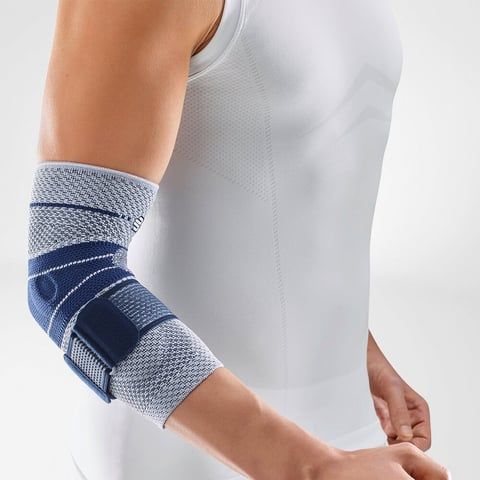Osteoarthritis - Elbow
Elbow osteoarthritis occurs when cartilage in the elbow joint begins to wear down. All ends of the three parts of the elbow joint are covered in articular cartilage, which can be up to 6 mm thick—though it is slightly thinner in the elbow. Cartilage is a springy tissue without blood vessels or nerves. Its smooth surface allows joint surfaces to glide past each other without damage. Osteoarthritis develops when this surface becomes rough rather than smooth. Want to learn more about this condition or browse our selection of elbow braces to relieve your symptoms? Read on below.
What are the symptoms of elbow osteoarthritis?
In cases of wear and tear, the joint surface becomes rough, and in advanced stages, the cartilage may be completely worn away. The ends of the bones, now unprotected by cartilage, rub directly against each other. The elbow may begin to crack or pop, and pain and stiffness are common. Initially, symptoms occur during movement, but may later also appear at rest. Mobility and flexibility in the elbow decrease significantly. Rotating, bending, and extending the elbow becomes difficult or painful. In severe cases, fluid may build up in the joint, visibly altering the appearance of the elbow.
What causes elbow osteoarthritis?
When a doctor attributes elbow pain and stiffness to cartilage wear, it is diagnosed as osteoarthritis. This can result from natural aging. Cartilage can also become damaged due to inflammation, such as in rheumatoid arthritis, which often affects both elbows. Osteoarthritis may also develop after a fracture in the elbow joint, as a result of joint damage. Additional risk factors include genetics, being overweight, and engaging in high-intensity sports.
What are the treatment options for elbow osteoarthritis?
A diagnosis of osteoarthritis can be confirmed by an X-ray, which will show reduced cartilage thickness and irregular joint surfaces. In the early stages of osteoarthritis, your doctor may refer you to a physical therapist. Through targeted exercises, the therapist can help strengthen and loosen the muscles around the elbow joint. Patients with stronger muscles around the affected joint often experience less pain and improved mobility.
Pain relief is often started with paracetamol. If that’s not effective, anti-inflammatory medication may be prescribed. In some cases, your doctor may recommend an injection into the elbow to reduce pain in the short term.
In advanced osteoarthritis, surgical treatment may be necessary. During an arthroscopy, loose cartilage fragments can be removed and rough ligaments smoothed out to reduce swelling and pain. The surgeon may also create small holes in the bone layer—this technique encourages scar tissue to fill in the damaged cartilage area, reducing pain and improving joint function. In severe cases, a joint prosthesis may be implanted.
To prevent further wear or to support recovery after surgery, there are several products that can help. At Podobrace, we offer a wide selection of elbow braces to support and protect your elbow during treatment and rehabilitation.

Bauerfeind Epitrain Elbow Bandage
Protection level 3
Super Ortho Elbow Support Sleeve

Novamed Premium Comfort Elbow Support

Lyon Premium Elbow Support

Dunimed Elbow Support (Available in Black & Beige)

Dunimed Elbow Support

- Physiotherapist
- Sports podiatrist
- Manual therapist
- Podopostural therapist
- Myofascial dry needling specialist


